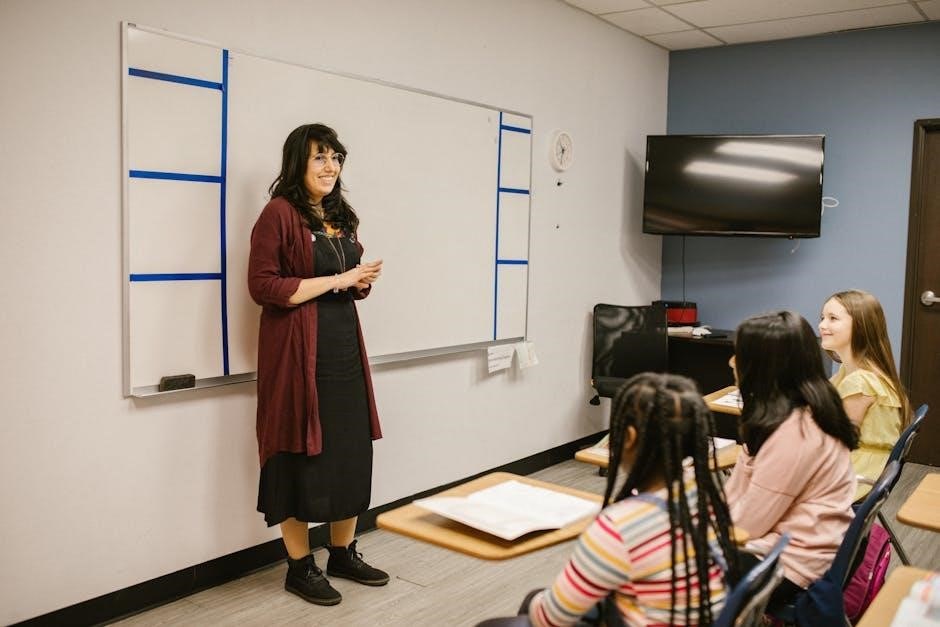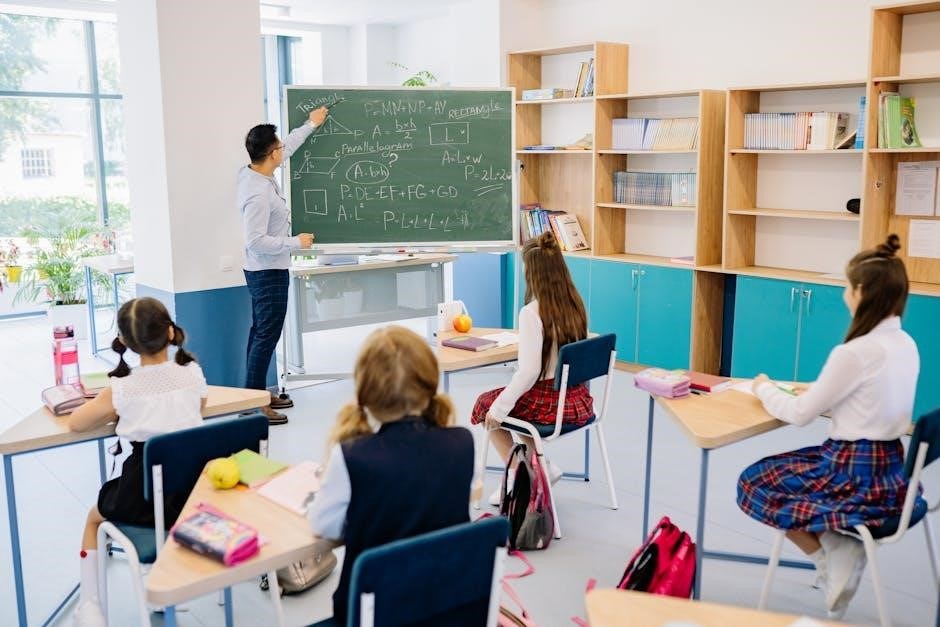Teacher-led instruction is a structured approach where educators guide learning through direct methods, leveraging their expertise to deliver content and manage classroom dynamics effectively.
1.1 Definition and Overview
Teacher-led instruction refers to a teaching method where educators actively guide student learning through structured lessons, direct delivery of content, and intentional classroom management. This approach emphasizes the teacher’s expertise in organizing and presenting information, ensuring students receive clear, focused instruction. It contrasts with student-centered methods by placing the teacher at the forefront of knowledge dissemination, ensuring alignment with curriculum goals and fostering an environment conducive to learning and academic progress. This method is foundational in many educational systems worldwide.
1.2 Importance of Teacher-Led Instruction in Education
Teacher-led instruction is vital for ensuring students receive structured, focused guidance aligned with curriculum standards. It leverages the teacher’s expertise to deliver content effectively, promoting academic achievement and critical thinking. This method ensures clarity and consistency, particularly for complex subjects, while allowing teachers to address diverse learning needs. By maintaining control over lesson pacing and content, educators can better manage classroom dynamics, reduce disruptions, and create an environment conducive to learning. This approach is particularly beneficial for younger students or those requiring additional support, fostering foundational skills and confidence.

Key Characteristics of Teacher-Led Instruction
Teacher-led instruction emphasizes direct instruction, structured lesson plans, teacher expertise, and classroom management, ensuring focused content delivery and effective learning outcomes for all students.
2.1 Direct Instruction and Its Role
Direct instruction is a cornerstone of teacher-led instruction, involving explicit teaching methods where the teacher actively delivers content, demonstrates skills, and guides student practice. This approach ensures clarity and structure, allowing for immediate feedback and correction. It is particularly effective in building foundational knowledge and skills, as teachers can address misconceptions promptly. By maintaining control over the learning process, educators can align instruction with curriculum goals, ensuring students meet expected outcomes efficiently.
2.2 Structured Lesson Plans and Organization
Structured lesson plans are essential in teacher-led instruction, providing a clear framework for content delivery; These plans outline objectives, materials, and activities, ensuring coherence and alignment with educational goals. Organization is key, as it enables teachers to manage time effectively and cater to diverse learning needs. By maintaining a structured approach, educators create an environment conducive to focused learning, minimizing distractions and maximizing student engagement. This systematic method supports both teacher efficiency and student comprehension, fostering a productive classroom atmosphere.
2.3 Teacher Expertise and Subject Matter Knowledge
Teacher expertise and deep subject matter knowledge are foundational to effective teacher-led instruction. Educators with strong content knowledge can explain concepts clearly, address misconceptions, and adapt instruction to meet student needs. Their expertise enables them to design engaging lessons, incorporate real-world examples, and foster critical thinking. Continuous professional development ensures teachers stay updated on best practices, enhancing their ability to deliver high-quality instruction and support student learning outcomes. This expertise is crucial for maintaining academic rigor and promoting student success in various educational settings.

Advantages of Teacher-Led Instruction
Teacher-led instruction enhances academic achievement, improves classroom management, and provides personalized learning opportunities, ensuring students receive tailored support and engage effectively with the curriculum.
3.1 Enhanced Academic Achievement
Teacher-led instruction significantly contributes to improved academic outcomes by ensuring students grasp foundational concepts through structured lessons and expert guidance. This method allows educators to address individual learning gaps, promoting deeper understanding and higher performance. Research indicates that direct teaching strategies, such as clear explanations and demonstrations, lead to better retention and mastery of subject matter. Additionally, regular formative assessments enable teachers to track progress and adjust instruction, further enhancing student achievement and preparing learners for future academic challenges.
3.2 Improved Classroom Management
Teacher-led instruction fosters a structured and disciplined learning environment, enhancing classroom management. Clear expectations, consistent routines, and active teacher supervision minimize disruptions, allowing students to focus on learning. This approach enables educators to address behavioral issues promptly, ensuring a productive atmosphere. By maintaining control and organization, teachers can allocate more time to instruction, leading to improved student engagement and reduced off-task behavior. Effective classroom management strategies within teacher-led models create a conducive setting for academic success and social development.

3.3 Personalized Learning Opportunities
Teacher-led instruction allows for tailored learning experiences, catering to individual student needs. Educators can identify strengths, weaknesses, and learning styles, adapting content delivery to ensure comprehension. Through formative assessments and feedback, teachers provide targeted support, fostering growth. This personalized approach ensures that each student progresses at their own pace, enhancing overall academic outcomes. By integrating differentiated instruction, teachers create a supportive environment where all learners thrive, regardless of their abilities or backgrounds.

Challenges in Implementing Teacher-Led Instruction
Challenges include balancing content delivery with critical thinking, managing diverse student needs, and maintaining engagement while adhering to structured lesson plans and curriculum requirements.
4.1 Student Engagement and Motivation
Engaging students in teacher-led instruction can be challenging, as it requires balancing structured content delivery with interactive methods. Motivation often wanes when lessons lack personal relevance or fail to incorporate diverse learning styles. Teachers must adapt their delivery to stimulate interest and encourage active participation, ensuring students feel connected to the material. Strategies like incorporating multimedia, real-world examples, and formative assessments can help maintain engagement and foster a more dynamic learning environment.
4.2 Balancing Content Delivery and Critical Thinking
Balancing content delivery with critical thinking in teacher-led instruction is crucial for fostering deeper understanding. While structured lessons ensure core concepts are covered, incorporating critical thinking exercises enhances cognitive engagement. Teachers must scaffold instruction to allow time for reflective practices, such as discussions or problem-solving tasks. This balance ensures students not only grasp the material but also develop analytical skills, preparing them for independent learning and real-world challenges.
4.3 Teacher Workload and Time Management
Teacher-led instruction often increases educator workload due to the demand for detailed lesson planning and continuous student assessment. Managing time effectively becomes critical, as teachers must balance content delivery with interactive activities. The pressure to cover extensive curricula while addressing individual needs can lead to burnout. Efficient organizational strategies and prioritization of tasks are essential to maintain a sustainable workload. Additionally, leveraging digital tools and collaborative planning with peers can help alleviate time management challenges, ensuring teachers can focus on fostering student growth and engagement.

Effective Strategies for Teacher-Led Instruction
Effective strategies include clear communication, interactive methods, and technology integration to engage students and promote deeper understanding, fostering a dynamic and productive learning environment.
5.1 Clear Goal Setting and Objectives
Clear goal setting and objectives are foundational to effective teacher-led instruction, ensuring alignment with learning outcomes and student success. By defining specific, measurable targets, educators provide direction and focus, enabling students to understand expectations and track progress. This approach also facilitates the organization of lesson plans and assessments, ensuring coherence and purpose. For instance, setting objectives like “students will analyze historical events” or “evaluate scientific concepts” guides instruction and enhances accountability. Clear goals also support personalized learning, allowing teachers to address diverse needs while maintaining academic rigor and relevance.
5.2 Incorporating Technology and Multimedia
Incorporating technology and multimedia enhances teacher-led instruction by engaging students through interactive and diverse learning experiences. Multimedia tools, such as videos, images, and simulations, simplify complex concepts and cater to various learning styles. Educational software and online platforms enable real-time assessments and personalized feedback, while interactive whiteboards and digital presentations make lessons more dynamic. This integration not only modernizes the classroom but also prepares students for a technology-driven world, fostering innovation and critical thinking. Effective use of technology supports teacher expertise and enriches the overall learning environment, making instruction more accessible and impactful for all students.
5.3 Formative Assessments and Feedback
Formative assessments and feedback are crucial in teacher-led instruction, allowing educators to monitor student progress and adjust teaching strategies. Regular quizzes, class discussions, and projects help identify learning gaps. Immediate feedback enables students to understand their strengths and areas for improvement. Teachers can then tailor lessons to address specific needs, enhancing academic outcomes. This iterative process fosters a supportive learning environment, encouraging student engagement and growth. By integrating formative assessments, teachers ensure that instruction remains aligned with student needs, promoting meaningful and continuous learning.

Real-World Examples and Case Studies
Case studies highlight teacher-led instruction’s effectiveness across diverse settings, showcasing improved academic outcomes, enhanced engagement, and personalized learning experiences in elementary, secondary, and special education environments.

6.1 Successful Implementation in Elementary Education
Teacher-led instruction has proven highly effective in elementary education, fostering foundational skills through structured, engaging lessons. Clear instructions and interactive activities ensure young students grasp concepts effectively. By incorporating technology, such as educational apps, teachers enhance learning experiences while maintaining control over lesson flow. This approach has led to improved test scores and higher student engagement, particularly in subjects like math and reading. Additionally, it promotes social skills development through guided group activities, creating a balanced and supportive learning environment tailored to young learners’ needs.

6.2 Application in Secondary and Higher Education
Teacher-led instruction is widely applied in secondary and higher education, emphasizing structured content delivery and critical thinking. Educators use advanced lesson plans, incorporating technology like multimedia tools, to engage students. This method fosters deeper understanding of complex subjects, such as science and mathematics. In higher education, it promotes independent learning while maintaining academic rigor. The approach ensures that students meet learning objectives, preparing them for future challenges in their fields of study.
6.3 Case Studies in Special Education Settings
Teacher-led instruction in special education settings involves tailored strategies to meet diverse student needs. Case studies highlight the effectiveness of structured, explicit teaching methods. Educators use formative assessments to monitor progress and adapt lessons, ensuring personalized learning. Collaboration among special education teachers, general educators, and support staff is crucial. This approach fosters an inclusive environment, enabling students with varying abilities to achieve academic and personal growth. Successful implementation often results in improved engagement and measurable outcomes for students with special needs.

Future Trends in Teacher-Led Instruction
Future trends include integrating AI for personalized learning, adopting blended learning models, and enhancing teacher professional development to innovate and refine instructional practices effectively.
7.1 Integration of Artificial Intelligence
AI is transforming teacher-led instruction by providing adaptive learning tools, real-time analytics, and automated assessments. These technologies enable personalized learning experiences, allowing teachers to tailor instruction to individual needs while maintaining classroom structure. AI-powered resources, such as virtual teaching assistants and intelligent tutoring systems, support educators in delivering high-quality instruction efficiently. This integration enhances engagement and academic outcomes, ensuring students receive targeted support. However, ethical considerations, such as data privacy and bias, must be addressed to ensure equitable and effective implementation of AI in education.
7.2 Blended Learning Approaches
Blended learning combines traditional teacher-led instruction with digital tools, creating a flexible and personalized learning environment. This approach allows students to engage with content both in-person and online, enhancing accessibility and engagement. Teachers can use online resources to supplement lessons, providing students with additional support and opportunities for self-paced learning. Blended learning also fosters collaboration and creativity, as students can interact with peers and materials in diverse ways. By integrating technology, blended learning enriches teacher-led instruction, preparing students for a rapidly evolving educational landscape while maintaining the benefits of direct teacher guidance.
7.3 Professional Development for Teachers
Professional development is crucial for enhancing teacher effectiveness in a rapidly changing educational landscape. Ongoing training enables educators to adopt innovative teaching strategies, integrate technology, and address diverse student needs. Workshops, conferences, and online courses provide platforms for skill enhancement; Collaborative learning opportunities, such as peer mentoring and coaching, further support teacher growth. By prioritizing professional development, institutions ensure teachers remain equipped to deliver high-quality, adaptive instruction, ultimately benefiting both educators and students in achieving academic success and fostering a dynamic learning environment.